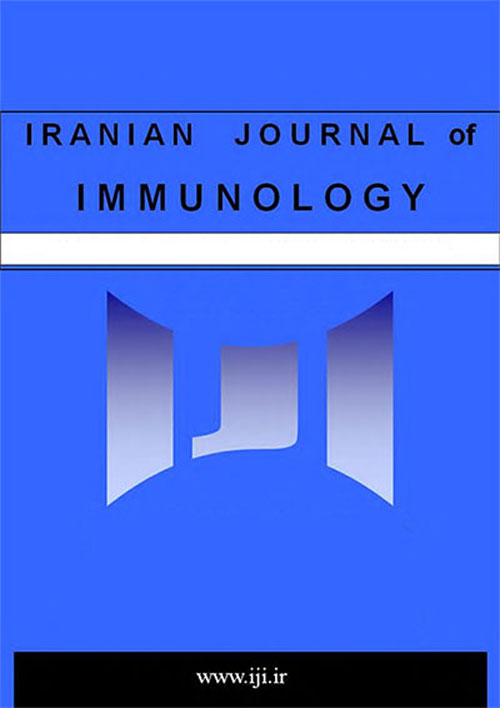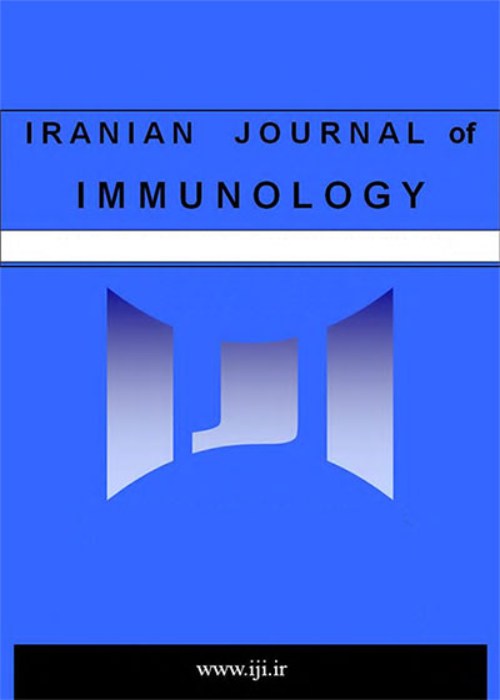فهرست مطالب

Iranian journal of immunology
Volume:16 Issue: 1, Winter 2019
- تاریخ انتشار: 1397/12/10
- تعداد عناوین: 9
-
-
Pages 1-10BackgroundAll-trans retinoic acid (ATRA) potentiates TGF-β-dependent regulatory T cells (Treg) induction, while it inhibits pro-inflammatory interleukin-17-producing T helper cells (Th17) differentiation. Combined application of ATRA and TGF-β may shift Treg-Th17 balance towards Treg.ObjectiveTo investigates the effect of ATRA on the regulation of Th17-Treg balance through ERK and p38 signaling pathway.MethodsMice naive CD4+T cells were isolated and co-cultured with 100 nmol/ml ATRA and 5 ng/ml TGF-β. The effect of ATRA on the phosphorylation of ERK and P38 was evaluated. The induction of Treg and Th17 was investigated before and after the application of the inhibitor of ERK and P38.ResultsThe expression of p-ERK1 and p-ERK2 increased significantly when the cells were incubated for 3 days with both TGF-β and ATRA. The upregulated expression of p38 was found after incubation for 1 day. The inhibition of ERK prohibited Treg induction and promoted Th17 development. However, the inhibition of p38 only had inhibitory effect on Treg induction.ConclusionsERK and p38 pathways participated in ATRA-activated Treg-Th17 balance adjustment.Keywords: All-trans Retinoic Acid_Erk_P38_Regulatory T cells_Th17 Cells
-
Pages 11-25BackgroundStimulated dendritic cells (DCs) have been shown to be effective in the induction of specific immune cells. Also, the CMV pp65 plays an important role in CMV life cycle and immune recognition.ObjectiveTo assess the effect of CMV pp65 on the maturity and function of dendritic cells.MethodsSplenic DCs were treated with non-cytotoxic concentrations of the pp65 and analyzed for MHC II, CD86, and CD40 expression by flow cytometry. Then, ROR-γ, GATA3, T-bet, and FOXP3 gene expression levels were evaluated in T cells co-cultured with DCs using Real time-PCR. Finally, the effects of pp65 on allogenic T-cell responses in mixed lymphocyte culture (MLR), and the release of cytokines were investigated by ELISA and flow cytometry.ResultsThe phagocytosis rate was significantly lower in the pp65-treated DCs than the non-stimulated DCs. There were significant differences in the raised level of CD40, CD86, and CCR7 in DCs as maturation markers. Furthermore, ROR-γ, and T-bet overexpression in T cells of the pp65-treated group compared with the non-stimulated group was observed. Significant differences were observed in the levels of IL-2, IL-6, IL-17, IL-22, TNF-α, and IFN-γ in pp65-stimulated groups compared with the non-stimulated DCs.ConclusionsThe pp65-treated DCs can induce differentiation and functional activity of the cellular immune system, including Th17, and Th1, but not other major T-cell subsets such as Tregs, and Th2 population.Keywords: Cytomegalo Virus, Dendritic cell, Function, Maturation, pp65
-
Pages 26-42BackgroundWe have recently produced an inhibitory mouse anti-human HER2 mAb (2A8) which displayed potent anti-tumor activity in combination with trastuzumab.ObjectiveTo describe chimerization and functional characterization of 2A8 mAb.MethodsThe VH and VL genes of 2A8 mAb were amplified from cDNA of the mouse hybridoma, ligated to constant regions of human immunoglobulin, and expressed in CHO cell line. Reactivity with four members of human HER family, the inhibitory effects and antibody-dependent cell cytotoxicity (ADCC) of purified chimeric mAb (c2A8) were assessed by ELISA, XTT, H3-tymidine incorporation and lactate dehydrogenase assays. Inhibition of ERK and AKT downstream signaling pathways by the chimeric antibody were analyzed by Western blotting.ResultsChimeric 2A8 mAb bound to recombinant human HER2 and did not cross-react with the other members of HER family. Moreover, c2A8 was able to recognize HER2-overexpressing cancer cell line and inhibited growth and proliferation of these cells. The binding affinity of c2A8 was comparable to the mouse parental mAb. ADCC and Western blotting results showed that the mouse 2A8 mAb was successfully chimerized and could significantly inhibit phosphorylation of AKT in combination with trastuzumab.ConclusionThe c2A8 mAb is potentially a valuable tool for targeted immunotherapy of HER2 positive cancers.Keywords: Breast Cancer, Chimeric Antibody, HER2, Immunotherapy, Monoclonal Antibody
-
Pages 43-52BackgroundMembers of B7 family are reported to regulate lymphocytes activation, transmit both costimulatory and co-inhibitory signals, control T cell-mediated immune responses and tolerance. Among which B7-H4 is reported to regulate the immune response negatively.ObjectiveTo investigate the plasma concentration of soluble B7-H4 (sB7-H4) and its clinical significance in systemic lupus erythematosus (SLE).MethodsFifty-six SLE patients with or without active SLE (ASLE) and 29 age- and gender-matched healthy volunteers were recruited. Plasma concentration of sB7-H4 was measured using sandwich ELISA kits.ResultsCompared with healthy subjects, the concentration of sB7-H4 was significantly higher in patients with SLE (p=0.006). Plasma sB7-H4 concentration in patients with lupus nephritis (LN) were also significantly higher than healthy subjects (p=0.008), but no difference was found between LN and SLE patients without LN (non-LN). Additionally, the sB7-H4 concentration in patients was negatively correlated with the SLE disease activity index score (SLEDAI) (r=-0.3055, p=0.022). Compared with inactive disease, the concentration of sB7-H4 in ASLE patients was significantly lower (p=0.002). There were statistical significances between the positive and negative groups with decreased leukocytes or thrombocytes (p=0.012; p=0.033; respectively), but no statistically significant difference was found in other positive and negative serum laboratory indicators.ConclusionsThe increased level of sB7-H4 in patients suggests that this pathway might be involved in the pathogenesis of SLE. However, the exact mechanism or physiological role of sB7-H4 in SLE pathogenesis remains to be investigated.Keywords: B7-H4, Lupus Nephritis, systemic lupus Erythematosus
-
Pages 53-61BackgroundInterleukin 17 (IL-17) is a pro-inflammatory cytokine that plays an important role in cancer pathogenesis.ObjectiveTo investigate the association of two IL-17 gene polymorphisms (rs2275913 and rs763780), as well as IL-17 serum levels with susceptibility to Basal Cell Carcinoma (BCC) of skin.MethodsTwo hundred subjects with BCC and 200 healthy controls were recruited. DNA was extracted from peripheral blood leukocytes and genotypes were determined using PCR-RFLP methods. Serum levels were assessed by ELISA.ResultsAt position rs2275913 in IL-17A, the frequencies of GG, AG and AA genotypes were 99 (49.5%), 76 (38%) and 25 (12.5%) in patients and 97 (48.5%), 84 (42%) and 19 (9.5%) in the control group. The distribution of AA, GA and GG genotypes at position rs763780 in IL-17F were 166 (83%), 34 (17%) and 0 (0%) in patients and 158 (79%), 40 (20%) and 2 (1%) in the control group. Haplotype analysis by Arlequin software package revealed that GA haplotype was the most frequent haplotype in both groups. No significant differences were found in alleles, genotypes, and haplotypes frequencies between study groups at both positions (P>0.05). While no difference in IL-17 serum levels was observed between individuals with different genotypes, statistical analysis showed higher IL-17A serum levels, but not IL-17F, in patients compared to controls (0.65 ± 0.11 and 0.03 ± 0.02 pg/ml), respectively, (P<0.001).ConclusionOur findings do not support the association of rs763780 and rs2275913 gene polymorphisms in IL-17gene with susceptibility of Iranians with BCC. Increased IL-17A serum levels may still play a role in pathogenesis of BCC.Keywords: Basal cell carcinoma, Interkulein-17, Single Nucleotide Polymorphism
-
Pages 62-70BackgroundUlcerative colitis (UC) and Crohn’s disease (CD) are the two forms of inflammatory bowel disease (IBD). Adaptive immune responses involving helper T cells play an important role in developing IBDs. Programmed death (PD)-1 and its ligands namely PD-L1 and PD-L2 are negative costimulatory molecules that control T cell motility and formation of an immune synapse between T cells and antigen-presenting cells (APCs).ObjectiveTo investigate the role of PD-L1 and PD-L2 in patients with UC to clarify the mechanism of IBD development.MethodsBiopsy specimens were obtained from 50 UC patients and 45 sex- and age-matched control subjects. Total RNA was extracted from all samples and applied for cDNA synthesis. Relative expression of PD-L1 and PD-L2 mRNA was determined using Taqman qRT-PCR.ResultsRelative gene expression levels of both PD-L1 and PD-L2 were higher in UC patients than the control groups (p<0.05 and p<0.01, respectively). Furthermore, both PD-L1 and PD-L2 expressions were positively correlated in all study subjects (r=0.339, p<0.001). However, among the groups with disease severity, the relative gene expression levels of PD-L1 and PD-L2 showed no significant difference.ConclusionsDuring IBD, the occurrence of PD-L1 and PD-L2 up-regulation may modulate the chronic inflammation of colonic mucosa.Keywords: PD-L1, PD-L2, Ulcerative colitis
-
Pages 71-83BackgroundSTAT4 is a transcription factor that plays a role in various cytokine signaling pathways and in T cell subsets differentiation. Several studies have reported STAT4 gene polymorphism in association with various autoimmune diseases.ObjectiveTo evaluated the association between STAT4 rs7574865 SNP and RA risk by meta-analysis.MethodsTwo major databases, namely Scopus and PubMed, were searched to find studies investigating the STAT4 polymorphism and RA in different populations up to November 2017. Association between STAT4 polymorphism and RA were analyzed using pooled odds ratio (OR) and their corresponding 95% CI.ResultsIn this meta-analysis, 21 population studies (16 papers) comprising 15,732 cases and 15641 healthy subjects evaluating the STAT4 gene rs7574865 SNP were included based on inclusion criteria. Herein, we found a significant positive association between minor T allele as well as different genotypes with the risk of RA.ConclusionsIn summary, this study revealed an association between STAT4 gene rs7574865 SNP and risk of RA.Keywords: Meta-analysis, Rheumatoid Arthritis, Rs7574865, STAT4, Single Nucleotide
-
Pages 84-91BackgroundEntecavir (ETV) is an antiviral medication effective in suppressing hepatitis B virus (HBV) replication and improving liver function. However, the relationship between antiviral effect and immune modulation after ETV therapy is not clearly understood.ObjectiveThe objective of this study is to investigate the immunoregulatory effect of ETV treatment in patients with chronic hepatitis B (CHB).MethodsThe frequencies of immune cells, including IFN-γ-producing CD4+ and CD8+ T cells, Th9 cells, regulatory T (Treg) cells, and myeloid-derived suppressor cells (MDSC) were determined in the peripheral blood from treatment-naïve and ETV-treated CHB patients. The plasma levels of IL-10, TGF-β, IL-9, TNF-α, IFN-γ, and Arg-1 were measured using enzyme-linked immunosorbent assay.ResultsThe results showed that ETV treatment significantly reduced the levels of liver function indices as well as HBV DNA loads in CHB patients. However, no significant difference in the immune cells percentage was found between the treatment-naïve and ETV-treated patients. Additionally, ETV treatment did not influence the production of TGF-β, IL-9, Arg-1, IFN-γ, and TNF-α. In contrast, the level of IL-10 was remarkably reduced after ETV therapy.ConclusionIL-10 was a more sensitive effector to ETV-induced inhibition of HBV replication in chronic HBV patients.Keywords: Chronic Hepatitis B, Cytokine, Entecavir, Immune Cells
-
Pages 92-95CD226 (DNAM-1) is a molecule that has been recently given a great deal of attention due to its immunomodulatory properties and possible usefulness in assessment of tumors and autoimmune disorders activity. This cellular transmembrane activating immunoreceptor is expressed predominantly on the surface of natural killer cells, most CD4+ T cells and CD8+ T cells, platelets, and monocytes (1). CD226, also known as DNAM-1 (DNAX Accessory Molecule-1), was originally described as an adhesion molecule that controls NK cell-mediated cytotoxicity (2). CD226 is also speculated to be an important suppressor of autoimmune responses (3). Single nucleotide polymorphism (rs763361) in CD226 gene, which leads to one amino acid substitution (Gly307Ser) in CD226, was reported to be associated with the development of several autoimmune diseases, including type 1 diabetes (T1D), multiple sclerosis, autoimmune thyroid disease (AITD) and rheumatoid arthritis (RA) (3). Interestingly, we and others reported that patients with distal 18q deletion syndrome - a natural model of CD226 haploinsufficiency, seem to be at higher risk of developing autoimmune conditions including T1D, AITD or vitiligo, coexisting with antibody and T regulatory cells deficiency (4). Membrane CD226 (mCD226) expressed on peripheral blood mononuclear cells might be shed from cell membranes by certain proteases and appear in the serum in its soluble (sCD226) form (5,6). There is a substantial body of evidence showing that sCD226 affects the interaction between CD226 and its ligands, resulting in modulation of CD226-mediated immune responses (7).Keywords: Autoimmunity, Age, Soluble CD226, sCD226 Serum Level


